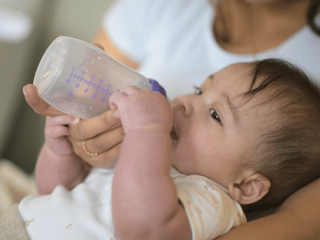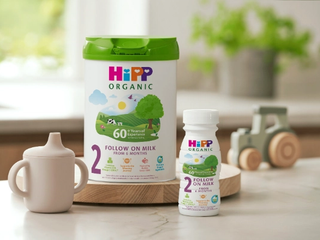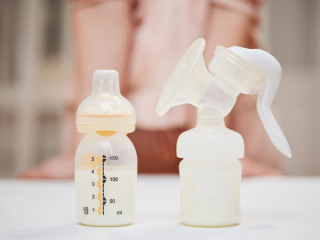
- Home
- Advice Hub
- Baby
- Baby Feeding
- What Is Breast Milk Made Of?
What is Breast Milk Made of?
Breast milk provides everything a baby needs for healthy growth and development. It contains all the essential nutrients needed to nourish and develop a baby’s immune system. For over 50 years, HiPP has studied breast milk to better understand its benefits, how its composition changes over time and the best ways to store it. Research from around the world into this ‘liquid gold’ helps improve formulas for parents who choose not to breastfeed.
What is in breast milk?
Breast milk is nutritionally complete, meaning that it has the right balance of everything needed for your baby’s development. Breast milk includes macronutrients like fats and proteins, and the balance of these can change over time to meet your baby’s needs. It also includes all the essential vitamins and minerals which are known as micronutrients. Breast milk also includes other compounds such as antibodies, enzymes and beneficial bacteria that help protect babies from infections and diseases, particularly during the early months when the immune system is still developing.
Macronutrients in breastmilk
All foods are made up of three macronutrients; fat, protein and carbohydrates, and these are all present in your breast milk. Breast milk provides them in just the right balance to promote healthy growth in babies.
Carbohydrates
Carbohydrates are the primary macronutrient in breast milk, providing energy for your baby. Lactose, the main carbohydrate, plays a vital role in brain development, calcium absorption, and helping grow beneficial gut bacteria in the digestive system. Breast milk also contains oligosaccharides, which are a complex carbohydrate-based sugar that act as ‘prebiotics’, which is a food that promotes the growth of beneficial microorganisms in the digestive system. Oligosaccharides cannot be digested by the baby and their purpose is to feed healthy gut bacteria, promote digestion, and help protect against infections. Together, lactose and oligosaccharides contribute to your baby's growth, development, and immune health.
Fats
Fats are an important part of breast milk providing around half of the calories in each feed. These fats help the development of your baby’s brain, the nervous system and help your baby gain weight and grow. Fats also help the body absorb certain vitamins including vitamin A, D, E, and K.
There are different types of fats found in breast milk, all with different jobs. Triglycerides make up most of the total fat content in breast milk and are a main source of energy for your baby. Another type of fat present in your breast milk is long-chain polyunsaturated fatty acids (known as LCPs) which are sometimes known as essential fatty acids. Omega-3 and Omega-6 are two types of these LCPs and are linked to both eye health and the development of the nervous system.
The fat content in breast milk can change throughout the day and even during a single feed. For example, the ‘hindmilk’ (the milk that comes out later in a feeding session) is richer in fats than the ‘foremilk’ (the milk that comes out first).
Protein
Protein is needed to build muscle, bone and blood, and develop enzymes and hormones that your baby needs. Breast milk contains over 400 proteins, are easy to digest and supply amino acids needed for development. There are two main types of protein found in breast milk which are whey and casein proteins. Whey proteins make up about 60% of the protein content and are easier to digest. Whey protein includes enzymes, antibodies, and lactoferrin, which helps protect against infections. Casein proteins digest more slowly, forming soft curds in the stomach, helping the baby feel full for longer. Proteins are not only essential for growth but also serve as natural antibodies, helping protect your baby from illnesses and infections.
Micronutrients in Breast Milk
Breast milk is rich in essential micronutrients, including vitamins and minerals, that are critical for your baby’s health and development. The balance of these nutrients are uniquely suited to your baby, although the levels can vary depending on the mother’s diet and overall health.
Vitamins
Vitamins in breast milk play a central role in growth and overall health and wellbeing. Vitamin A is important for healthy vision, skin, and strengthening the immune system. Vitamin D, supports the development of strong bones and helps your baby to absorb calcium. Everyone, including pregnant and breastfeeding women, should consider taking a daily supplement containing 10mcg of vitamin D. Vitamin E acts as a natural antioxidant, protecting the baby’s cells from damage, while vitamin K helps with blood clotting and reducing the risk of bleeding.
Calcium
In addition to vitamins, breast milk contains minerals like calcium, phosphorus, magnesium, zinc, and iron. In breast milk these minerals are present in forms that can be easily absorbed by your baby. Calcium is important for growing strong bones and teeth, while iron helps produce red blood cells. Zinc is essential for growth and developing a strong immune system. Together, these vitamins and minerals provide the foundation for your baby’s healthy development.
The role of antibodies and other immune-boosting components
Hopefully, by now we will have helped answer the question ‘what is breast milk made of?’ But, there’s more - as breast milk also contains lots of other important natural substances that contribute to your baby’s healthy development.
Human milk oligosaccharides (HMOs), as mentioned before in the macronutrients section, are indigestible complex sugar molecules which support your baby’s immune system and strengthen their defences. This in turn will help promote healthy and comfortable digestion. Breast milk contains lots of different types of these oligosaccharides, which also help soften the stools of breastfed babies.
There are also a range of different types of microorganisms are present in your breast milk. Some are common to the breast milk of all mothers, but others will differ depending on your nutrition and own immunity, environmental and lifestyle factors. These microbiota are types of microorganisms that will be passed onto your baby and help to shape their own unique intestinal microbiota, which helps protect them against infections.
There are also various antibodies (immunoglobulins), and anti-infective agents present in your breast milk which help build your baby’s defences by coating the baby’s intestinal lining and helping to block harmful pathogens. Lactoferrin is an immune-boosting type of protein that helps babies absorb nutrients such as iron and helps stop the growth of harmful bacteria. There are additional growth factors that have wide-ranging effects on the gut, blood, nervous system, and on hormones which regulate metabolism and body composition.
Together, the nutrients and other various biological components of breast milk help with digestion, the absorption of nutrients and protection against infections, making it the best food for your baby.
How breast milk composition changes over time
The composition of breast milk is dynamic, meaning that its composition of nutrients can change to meet your baby’s needs as they grow. There are 3 stages of breastmilk development:
Stage one
Stage one is the production of Colostrum during days 1–5 and is perfectly tailored for a newborn’s tiny digestive system. This thick, yellow milk is the first nourishment your baby receives after birth. It is rich in proteins, antibodies, and white blood cells, designed to boost your baby’s immune system. Colostrum is lower in fat and carbohydrate compared to mature breastmilk with the high protein content helping with fast cell growth of a newborn.
Stage two
Stage two is the introduction of transitional milk, occurring around days 5 to 14. As your milk supply increases, transitional milk contains more lactose, fat, and calories to meet the increasing energy needs of a growing baby with the addition of high levels of protein. During this stage, breast milk begins to shift towards a composition more similar to mature milk.
Stage three
By around two weeks postpartum, breast milk stabilises into its mature form, which is the third and final stage. Mature breast milk provides a balanced mix of nutrients to support ongoing growth and development. Levels of protein gradually decrease as your baby’s growth rate slows and becomes steadier.
How can you store breast milk?
Storing breast milk safely is essential for mums who pump or express, and plan to use the breast milk later. Following proper storage guidelines will help your breast milk to keep its nutrients and also be safe for feeding to your baby.
Freshly expressed breast milk can be kept out at room temperature (up to 25°C) for up to 4 hours. For longer storage, breast milk must be kept in the fridge, where it can be used for up to 4 days in a fridge kept at 4°C or cooler. To store breast milk for longer periods, it should be frozen. Breast milk can be kept in a standard freezer (-18°C) for up to 6 months or in a deep freezer (-20°C) for as long as 12 months. It is advised to always use clean, sterile containers for breast milk storage.
If freezing breast milk, containers should be ‘freezer-safe’, and using breast milk storage bags can be helpful for saving space in your fridge or freezer. Each container should be labelled with the date and time that it was expressed so you can use the oldest breast milk first. Avoid using a microwave to thaw breast milk as it can destroy some of the nutrients. Instead use the fridge or place the container in warm water to thaw.
Final Thoughts
Breast milk is nature’s perfect source of nutrition, providing all the necessary macronutrients, micronutrients and immune-boosting compounds that help your baby grow and fight infections and diseases. Breast milk adapts over time to meet the changing needs of a growing baby, making sure each feed is tailored to the baby’s development. By following safe storage guidance, breast milk can continue to nourish and protect a baby even when direct breastfeeding is not possible.
Important Notice
We recognise that breastfeeding is best, providing many benefits to both mothers and infants. We also recognise that every parenting journey is unique, and we are here to support you through this journey, however you choose to feed your baby.
If you choose to breastfeed it is important that you eat a healthy well-balanced diet in preparation for and during breastfeeding. Before deciding to combination or formula feed your baby, note that reducing or stopping breastfeeding can be difficult to reverse. Babies feed on demand, so replacing breastfeeding with infant formula milk may reduce your supply. Formula feeding has both social and financial implications. Talk to your midwife or health visitor for guidance and support.
If you choose to use formula milk, make sure you choose the right milk for your baby’s age and prepare and store it according to the instructions on the packaging. Not doing so may make your baby ill. Infant formula is a nutritionally complete breastmilk substitute that can be used from birth. From 6 months you can choose to use follow on milk as part of a mixed diet and from 12 months you have the option to move onto growing up milk alongside a balanced diet.












